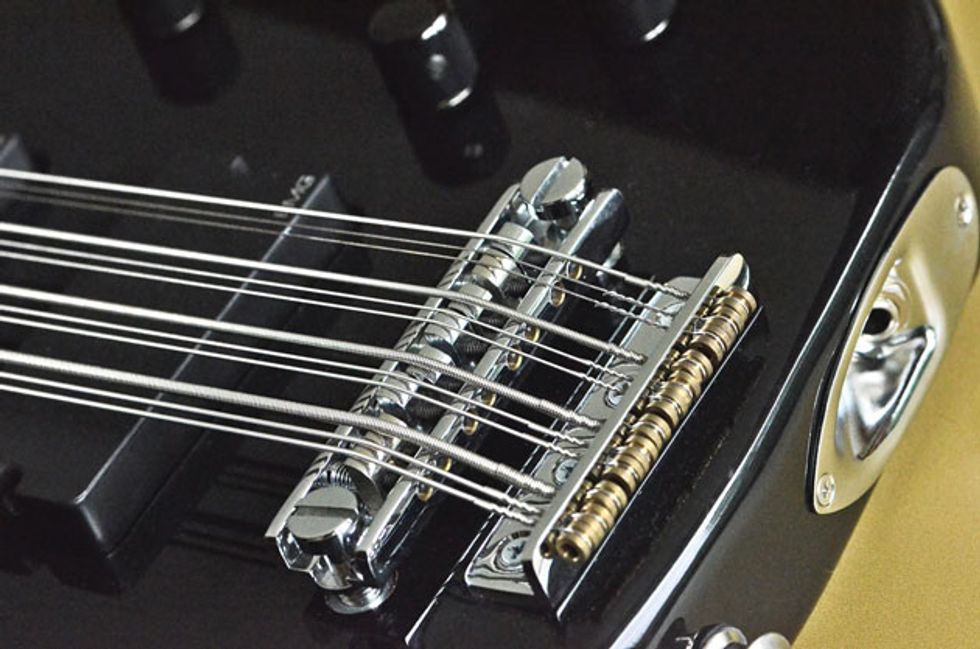As the joke goes, half the time you spend playing a 12-string is spent tuning, and the other half playing out of tune. That certainly wasn’t on Cheap Trick bassist Tom Petersson’s mind when he envisioned the world’s first 12-string bass.
Prior to that time, basses were primarily 4-string devices. Fender had offered a 5-string (with a high C), and after noting the existence of the 6-string Danelectro Longhorn in the late ’50s, Leo’s crew introduced the Bass VI 6-string in 1961. Hagstrom broke the mold a few years later with the first commercially available 8-string bass in 1967. The Hagstrom H-8 was unique in that it featured four pairs (known as courses) of strings tuned an octave apart—giving the instrument the sound of a bass and a standard guitar playing in unison. Although just over 2,000 were made between 1967 and 1969, the H-8 had been famously used by the Jimi Hendrix Experience on several recordings, including “You Got Me Floatin’” and “Spanish Castle Magic.” The unique model became a sort of cult instrument with progressive rock bassists, and by the mid ’70s, Petersson had gotten his hands on one.
Petersson had been trying the Hagstrom H-8 in the band’s sets, but he found its intonation less than satisfactory and asked me if there was anything that could be done to improve it. Because our fledgling company, Hamer Guitars, had already built instruments for Cheap Trick, Petersson also asked if we would build a new kind of bass for him that would expand on the Hagstrom and solve the intonation as well. He envisioned a bass with four courses of three strings, like an ancient tiple, for a total of 12 strings. Because we had reservations about the neck being able to stand up to the force of all those strings, a compromise to test the theory was agreed upon: a 10-string bass. By keeping the bottom two courses (A and E) as pairs, we felt that a beefy neck would hold steady. In order to simplify tuning and reduce confusion, I suggested three different-sized tuners for each course. That way Petersson could easily find the right string to tune.
We still faced the same intonation problem that Petersson had experienced on the H-8. Because the Hagstrom only had four saddles on its bridge, the octave strings could not be adjusted separately from the low strings, and therefore intonation was a compromise. To accomplish the proper intonation so critical to Petersson, I had to come up with a bridge system that allowed for separate adjustments for the octave strings. For this, I turned to a familiar design used on vintage Thunderbird basses. It was a simple U-channel design, not unlike those found on many lap steels. The difference would be that instead of four saddles, my version would have eight. And because the octave strings in each course were tuned in unison, they could share a saddle and be intonated together. Most importantly, they were adjusted separately from the low strings and the original cause of the problem could be solved.
The first prototype was completed in 1977 and delivered to the band along with an 8-string mandocello built for Rick Nielsen. The fact that between these two instruments the guys would be strumming the equivalent of three guitars? Fascinating proposition! When Petersson reported back that the bass’ neck was holding up just fine, it brought a sigh of relief and opened the door for us to go ahead with the B-12.
Once Petersson had the 12-string bass, there was no looking back. It became his signature sound. And though it hasn’t become a mainstream instrument, the power and sound of the B-12 has been fundamental to a lot of great music over the years. Petersson’s vision has inspired new generations of bassists to add the B-12 to their own repertoire. If you want to know what a B-12 sounds like, you need only listen to the opening refrain of Pearl Jam’s “Jeremy” or Metallica’s “Wherever I May Roam” to get an idea of the sonic range they possess. We all have Tom Petersson to thank for that.






![Rig Rundown: AFI [2025]](https://www.premierguitar.com/media-library/youtube.jpg?id=62064741&width=1245&height=700&quality=70&coordinates=0%2C0%2C0%2C0)












 Shop Scott's Rig
Shop Scott's Rig















































